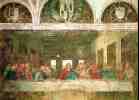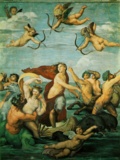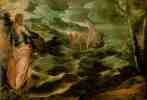
Examples of their work include:

Leonardo
da Vinci (Italian, 1452-1519), Madonna with a Flower (Benois Madonna),
oil on canvas,
49.5 x 33 cm, State Hermitage Museum, St. Petersburg, Russia.
See Madonna.

Leonardo da Vinci, Ginevra de' Benci, c. 1474, oil
on wood panel,
15 1/8 x 14 1/2 inches (38.2 x 36.7 cm), National Gallery of
Art, Washington, DC. See portrait.
Leonardo da Vinci, The Adoration of the Magi, 1481-82, yellow ochre and brown ink on wood panel, 8 x 8 feet (246 x 243 cm), Uffizi, Florence.
Leonardo da Vinci, Lady with an Ermine, 1483-90, oil on wood panel, 21 x 15 1/2 inches (53.4 x 39.3 cm), Czartoryski Museum, Cracow.
Leonardo da Vinci, Study of proportions, from Vitruvius's De Architectura, red crayon with pen and ink on paper, 13 1/2 x 9 5/8 inches (34.3 x 24.5 cm), Accademia, Venice.
Leonardo da Vinci, Skull, 1489, red crayon with pen and ink on paper. This is a lateral view of a human skull with the left half of the calvaria removed to expose the interior. This is one of a huge number of anatomical drawings Leonardo made, to most of which he added written notes. He said he had dissected over thirty human bodies-- men and women of varied ages. See text.

Leonardo
da Vinci, Womb, or "The Foetus in Utero,"
1489, red crayon with
pen and ink
on paper, Collection of Queen Elizabeth
II, Windsor Castle.

Leonardo da Vinci, Madonna Litta, c. 1490-91, tempera
on canvas, transferred
from panel, 16 1/2 x 13 inches
(42 x 33 cm), Hermitage, St. Petersburg, Russia. See sfumato
and Madonna.

Leonardo
da Vinci, The
Last Supper, 1498, modified fresco, 15 x 29 feet (460 x 880 cm), Convent
of Santa Maria delle Grazie (Refectory), Milan.
Leonardo da Vinci, Head of a Young Woman, Accademia, Venice.
Leonardo da Vinci, The Virgin of the Rocks, 1503-06, oil on wood panel, 6 x 4 feet (189.5 x 120 cm); National Gallery, London.
Leonardo da Vinci, Mona Lisa (La Joconde) (1479 - d. before 1550), c. 1503-1506, oil on wood panel, 77 x 53 cm, Louvre. Many artists have created their own versions of this image. See aerial perspective and sfumato.
Leonardo da Vinci, Virgin and Child with the Infant John the Baptist and St. Anne, National Gallery, London, sketch for the painting Madonna and Child with St. Anne and John the Baptist. This drawing is often identified as the Burlington House Cartoon. Leonardo's later treatment of the same subject (without John the Baptist) is in the Louvre. See cartoon.

Leonardo da Vinci, The Virgin and Child with Saint Anne,
1510, oil on wood
panel, 5 1/2 x 4 1/2 feet (168
x 130 cm), Louvre, Paris.

Michelangelo
Buonarotti (Italian, 1475-1564), David (detail: the head), marble, started in 1501 and completed
in 1504. Michelangelo began work on the colossal figure of David in 1501, and by 1504 the sculpture,
standing at 14 feet 3 inches tall (4.34m), was in place outside
the Palazzo Vecchio. The choice of David was supposed to reflect
the power and determination of Republican Florence, and was under
constant attack from supporters of the usurped Medicis. In the
nineteenth century the statue was moved to the Accademia.
Michelangelo Buonarotti, The Holy Family with the infant St. John the Baptist (the Doni Tondo), c. 1503-05, tempera on wood panel, diameter 47 inches (120 cm), Uffizi, Florence.

Michelangelo, Signorelli, Girlandaio, and
others, fresco
paintings in the Sistine Chapel, Vatican, Rome. Michelangelo
repainted the chapel's ceiling between 1508 and 1512. Details
of the ceiling: Creation of the Sun and Moon, Delphic Sylph, Cummic Sybil, and The Creation of Adam. He later painted the
Last Judgement over the altar, between 1535 and 1541.

Giorgione
(Giorgio da Castelfranco) (Italian, 1477-1510), Judith, oil
on canvas (transferred
from panel), 56 1/2 x 26 inches
(144 x 68 cm), Hermitage Museum, St. Petersburg, Russia.

Raffaello Sanzio "Raphael" (Italian,
1483-1520), Madonna and Child (Madonna Conestabile),
1502/3, tempera on canvas
(transferred from panel), 7 x 7
inches (17.5 x 18 cm), State Hermitage Museum, St. Petersburg,
Russia.

Raffaello
Sanzio, "Raphael", St. George Fighting the Dragon, 1504-06,
oil on wood
panel, 11 1/8 x 8 3/8 inches (28.5
x 21.5 cm), National Gallery of Art, Washington, DC.
Raffaello Sanzio, "Raphael", St. George Fighting the Dragon, 1505, oil on wood panel, 12 x 10 1/4 inches (30 x 26 cm), Musee du Louvre, Paris.
Raffaello Sanzio, "Raphael", The small Cowper Madonna, c. 1505, oil on wood panel, 23 3/8 x 17 3/8 inches (59.5 x 44 cm), National Gallery of Art, Washington, DC. See Madonna.

Raffaello Sanzio, "Raphael", Granduca Madonna, c. 1505, oil
on wood panel,
33 x 21 1/2 inches (84 x 55 cm), Pitti Palace, Florence.

Raffaello
Sanzio, "Raphael", The Holy Family (Madonna with the Beardless Joseph),
1506, tempera on canvas
(transferred from panel), 28 1/2
x 22 1/2 inches (72.5 x 56.5 cm), Hermitage Museum, St. Petersburg,
Russia.
Raffaello Sanzio, "Raphael", Portrait of Maddalena Doni, c. 1506, oil on wood panel, 24 3/4 x 17 3/4 inches, Pitti Palace, Florence. See portrait.

Raffaello Sanzio, "Raphael", The Nymph Galatea, c. 1512-14, fresco, 116 x 88 1/2 inches (295 x 225 cm),
Villa Farnesina, Rome.
Raffaello Sanzio, "Raphael", Bindo Altoviti, c. 1515, oil on wood panel, 23 1/2 x 17 1/4 inches (60 x 44 cm), National Gallery of Art, Washington, DC.
Raffaello Sanzio, "Raphael", Pope Leo X with two cardinals, 1518, oil on wood panel, 60 5/8 x 46 7/8 inches (154 x 119 cm), Uffizi, Florence.

Titian (Tiziano Vecellio) (Italian [Venetian],
c. 1485/90-1576), Madonna with saints and members of the Pesaro
family, 1519-26, altar-painting:
oil on canvas,
188 1/8 x 104 3/4 inches (478 x 266 cm), Church of Sta Maria
dei Frari, Venice. See altarpiece.

Titian
(Tiziano Vecellio), Venus with an Organist and a Dog, oil on canvas,
Prado Museum, Madrid.

Titian (Tiziano Vecellio), Penitent Mary Magdalen, 1560s, oil
on canvas, 46 1/2 x 38
inches (118 x 97 cm), Hermitage, St. Petersburg.
Leone Leoni (Italian, 1509-1590) and Pompeo Leoni (Italian, 1533-1608)
Tintoretto (Jacopo Robusti) (Italian [Venetian], 1518-1594), St. George and the Dragon, c. 1555-8, oil on canvas, 62 x 39 1/2 inches (157.5 x 100.3 cm), National Gallery, London.

Tintoretto (Jacopo Robusti), Christ at the Sea of Galilee, c. 1575-80,
oil on canvas,
46 x 66 1/4 inches (117 x 168.5 cm), National Gallery of Art,
Washington, DC.
Also see cinquecento, Northern Renaissance art, and Renaissance.
https://inform.quest/_art